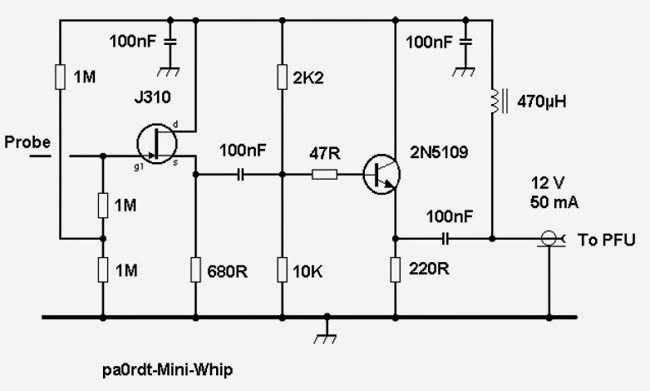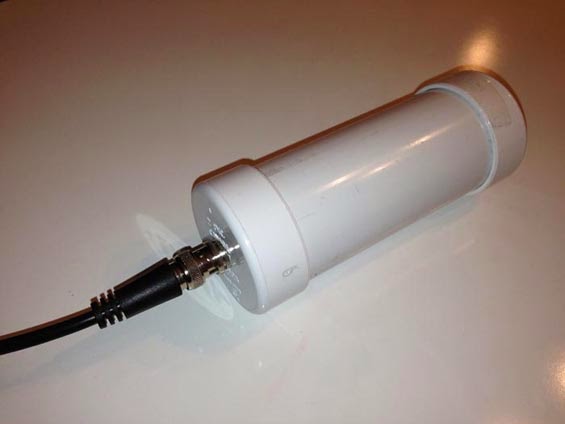 The PAØRDT Active Whip….On LF
The PAØRDT Active Whip….On LF
 |
| The Mini-Whip at University of Twente's (Netherlands) Remote Receiver |
I think many hams believe that they need big antennas and lots of space to operate on 630m or even to listen on the band. I can assure you that big antennas are definitely not needed to listen or for that matter, even to transmit effectively.
You might be surprised at just how well you can hear on 630m using one of your low band antennas, such as an 80m or 40m dipole. Best results will be had with the coaxial feed's shield lifted from ground and connected to the center pin. This, in effect, allows your dipole to act as a top-loaded 'T', with the coaxial feedline now acting as the vertical element and the dipole section as a capacitive tophat. With a few ground radials, such an antenna can even be used for transmitting, if suitably resonated, but that's another topic altogether. Even untuned, this system will allow you to receive suitably on 630m providing your location is not inundated with high noise levels. High noise levels can often be overcome by using loops, either resonated or broadband. Loops can be very effective at nulling noise, particularly if it is coming from one direction, and vastly improving LF receive-capabilities.
Another popular solution and one that can be quite effective at lowering noise levels and improving overall signal-to-noise is the use of a short active (amplified) whip antenna. One very popular and proven design is that of Roeloff Bakker, PAØRDT. His simple-to-build active whip has been employed around the world and is being used by many LF'rs for dependable reception on the NDB band as well as on 630m. Roeloff himself operates from a noisy urban area yet manages to hear amazingly well on LF and MF with this simple antenna. Unlike a much larger wire antenna or large loop, the small active whip can be easily positioned in the quietest part of your backyard or rooftop. Often just moving such an antenna a few feet one way or the other can make a huge change in the noise level if you are operating from a typical city or suburb location....the PAØRDT whip may be all that you really need for long-term, reliable LF reception.
 |
| Courtesy: PAØRDT |
Common practice is to mount the PCB inside a small weather-sealed PVC pipe and erect it atop a mast, after taking the time to "sniff-out" the quietest location for its placement.
 |
| Courtesy: http://www.leeszuba.com/projects/ |
With very few parts needed, the whip can be built for just a few dollars...even less with a good junkbox and the needed transistors.
 |
| Courtesy: http://www.leeszuba.com/ |
You can read Roeloff's own information on construction of the active whip here, with additional information here.
I even see the parts and PCB available on e-bay. As well, Roeloff himself, can provide finished units ready to mount in the air.
 |
| Courtesy: http://countingradios.blogspot.ca/2014_01_01_archive.html |
There are plenty of informative Mini Whip articles and construction stories on the web should you wish to learn more:
- Fundamentals of the Mini Whip by PA3FWM
- The PAØRDT Mini Whip by DL1DBC
- The Mini Whip Antenna by Lee Szuba














Steve —
I’d like to add two posts that help explain how exactly Mini-Whip works and… how it depends on the feedline.
First one is an article from VK1OD Owen Duffy published in 2013. Unfortunately, Owen changed his call-sign and preferred not to continue with his brilliant web site. The article, however, is still available at Archive.org (link follow). Owen provides both a model for the antenna works and practical tests with video.
Owen’s article:
http://web.archive.org/web/20130914024511/http://vk1od.net/antenna/PA0RDT-MiniWhip/index.htm
Owen’s video:
http://www.youtube.com/watch?v=EWqJHTOijdE
The second item is a post from Mini-Whip author him self. Roelof experimented his antena with optical cable (instead of coax). Here’s his findings:
https://groups.yahoo.com/neo/groups/ndblist/conversations/topics/65535
I think it’s noteworthy to include a mention to K8ZOA Jack Smith’s Clifton Laboratories page too – http://www.cliftonlaboratories.com/ . Jack has several products, being recognized by his pre-amps and active antenna. All his projects have the schematics available. And Jack also spends quite a few paragraphs how one should properly install the active antenna, feedline and baluns to avoid noise.